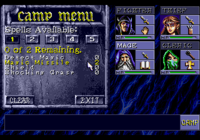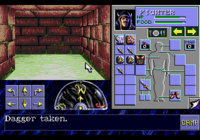Eye of the Beholder
From Sega Retro
| |||||||||||||||||||||||||
| Eye of the Beholder | |||||||||||||||||||||||||
|---|---|---|---|---|---|---|---|---|---|---|---|---|---|---|---|---|---|---|---|---|---|---|---|---|---|
| System(s): Sega Mega-CD | |||||||||||||||||||||||||
| Publisher: Pony Canyon (Japan), Sega of America (US), Sega Europe (Europe) | |||||||||||||||||||||||||
| Developer: Opera House | |||||||||||||||||||||||||
| Licensor: TSR | |||||||||||||||||||||||||
| Original system(s): IBM PC | |||||||||||||||||||||||||
| Developer(s) of original games: Westwood Associates, Strategic Simulations, Inc. | |||||||||||||||||||||||||
| Peripherals supported: CD BackUp RAM Cart, Sega Mouse | |||||||||||||||||||||||||
| Genre: RPG[1][2] | |||||||||||||||||||||||||
| Number of players: 1 | |||||||||||||||||||||||||
| |||||||||||||||||||||||||
|
Eye of the Beholder (アイ・オブ・ザ・ビホルダー) is a Sega Mega-CD RPG. The game is set in the Forgotten Realms setting, with gameplay based on the Advanced Dungeons & Dragons ruleset. It is the first in a trilogy of Eye of the Beholder games.
Contents
Story
The lords of the city of Waterdeep hire a team of adventurers to investigate an evil coming from beneath the city. The adventurers enter the city's sewer, but the entrance is blocked by a collapse caused by Xanathar, the eponymous beholder. The team descends further beneath the city, going through the dwarf ruins and drow reaches, to Xanathar's lair, where the final confrontation takes place.
Gameplay
The game is a dungeon crawler using a first-person perspective in a three-dimensional environment, in a manner similar to the earlier PC game Dungeon Master. The dungeon has twelve levels. The game does not provide maps of the levels, so players typically draw a map while playing or use an existing one from an outside resource. The player controls four characters initially, but this can be increased to a maximum of six characters by resurrecting skeletons found in the dungeon or by finding NPCs. At the start of the game, the player can choose to create a new party or use a default party.
When forming a new party, the player creates four characters and chooses each character's race, gender, class, alignment, portrait, and name. The default party, if chosen, consists of a male human fighter (neutral good), a female gnome thief (true neutral), a male elf mage (lawful evil), and a female half-elf cleric (neutral good).
The game uses a point-and-click interface to navigate the maze-like dungeon and fight monsters. It can be played using a standard control pad or with the Sega Mouse. Using a control pad, the D-Pad moves the cursor and ![]() speeds up the cursor movement.
speeds up the cursor movement. ![]() or
or ![]() performs the selected action (equivalent to a mouse click). The game has options to change the cursor movement speed and to automatically snap the cursor to buttons and objects on the screen.
performs the selected action (equivalent to a mouse click). The game has options to change the cursor movement speed and to automatically snap the cursor to buttons and objects on the screen.
The game shows a first-person view of the dungeon, direction arrows and a compass for navigation, a status area for messages, and a list of party members. The player can interact with objects in the dungeon, including picking up items (to place in a character's inventory) or pressing buttons and flipping levers. The player can move through the dungeon by pressing the arrow buttons with the cursor, but the player can also move more quickly through the dungeon by holding START and pressing any direction on the D-Pad.
The character list shows all of the party members with the equipment in their primary hands and off-hands and their current hit points. The two characters on the top of the list are in the front of the party. These are the only characters able to attack with melee weapons, and they take the brunt of the damage. The lower characters are in the rear and can only use ranged weapons and spells. Clicking on a party member shows the character's complete inventory, including equipped weapons and armor. Each character has a backpack containing unequipped items, a quiver that can be filled with arrows for use with a bow, and a belt pouch that can be filled with items that need to be quickly accessed in battle (such as throwing weapons, which are automatically transferred from the belt pouch to the character's hands when spent in combat). The player can also view the character's statistics by selecting the page flip icon, including the character's current level and experience points.
In addition to hit points, each character has a food level, which goes down as time passes. If a character is starving, the character loses a hit point for every 24 hours of in-game time and cannot memorize or pray for spells. The party finds rations in the dungeon, which can be eaten by placing it on the plate in the character's inventory screen.
While exploring the dungeon, encounters with malevolent creatures happen randomly. Battles are played in real-time and start as soon as a monster appears (without a transition to a separate battle scene). A character can be ordered to attack by selecting a weapon in his or her hand with ![]() . Mages, clerics, and paladins can be ordered to cast spells by selecting their spellbooks or crosses (in their off-hands) with
. Mages, clerics, and paladins can be ordered to cast spells by selecting their spellbooks or crosses (in their off-hands) with ![]() and then selecting a spell from the list that appears. Characters earn experience and items from defeating monsters in combat. If a character is slain in battle, the character is dead until revived by a spell. Characters are revived with a single hit point and starving. The game ends if the entire party dies.
and then selecting a spell from the list that appears. Characters earn experience and items from defeating monsters in combat. If a character is slain in battle, the character is dead until revived by a spell. Characters are revived with a single hit point and starving. The game ends if the entire party dies.
Rather than using magic points as in most role-playing games, spellcasters must memorize or pray to learn spells in advance. Each spellcaster has an inventory of spells and a certain number of points to spend learning spells (which can be used to learn the same spell multiple times in order to use it more than once), and using a spell expends one use of that spell. Spells are learned when resting.
The "Camp" button contains a number of important functions, including resting the party, dropping party members (in excess of the starting four), and saving or loading the game. Resting is used to heal the party and to memorize or pray to learn spells. The amount of time spent resting depends on how wounded the characters are or how many spells are being learned. Rest can be interrupted by wandering monsters.
Character Creation
Races
The races are human, elf, half-elf, dwarf, gnome, and halfling. The race of a character determines which classes are available. Humans are the only race with access to all six classes, but because of their longer lifespans, the other races can create multi-class characters.
| Race | Classes | Ability score modifiers | Other modifiers | Level restrictions |
|---|---|---|---|---|
| Human |
|
— | — | — |
| Elf |
|
Dexterity +1, Constitution -1 | +1 bonus when wielding bow or long or short sword, resistant to sleep and charm spells | — |
| Half-Elf |
|
— | Resistant to sleep and charm spells | — |
| Dwarf |
|
Constitution +1, Charisma -1 | — | Cleric 10th level |
| Gnome |
|
Intelligence +1, Wisdom -1 | +1 bonus against kobolds | Cleric 9th level |
| Halfling |
|
Dexterity +1, Strength -1 | +1 bonus with slings, magic resistance | Cleric 8th level, Fighter 9th level |
Classes
Classes are occupations, which determine the character's aptitudes and abilities. The available classes are as follows:
- Fighter: The standard warrior class and the best attackers. They can equip any weapon or armor, though they are most adept with melee weapons such as swords. They do not learn any magic spells, but they can equip magical weapons, armor, and trinkets. They gain speed as they gain levels, allowing them to attack more in combat.
- Ranger: Light, agile warriors. They can equip weapons in both hands when wearing light armor. They do not learn any magic spells. Paladins cannot join parties with evil members.
- Paladin: Elite warriors. They are immune to disease and possess extra resistance to magical attacks and poison, and they provide the party with a protective aura that acts as a negative affect on evil creatures that come too close. In addition to their battle prowess, they can learn some cleric spells, including the ability to heal other party members and to repel undead. Paladins learn spells by praying for them when resting.
- Mage: Offensive spellcaster. They are poor at hand-to-hand combat and also poor defensively as they can only equip robes as armor. As they gain levels, they gain more spell points for learning more spells. Mages learn spells by memorizing them when resting.
- Cleric: Warrior priest. They learn defensive abilities, including healing spells, and they are especially adept at repelling the undead. Clerics learn spells by praying for them when resting.
- Thief: Support class. Thieves can pick locks and disarm traps. They can only wear light armor.
| Race | Main attributes | Weapons allowed | Experience levels | ||
|---|---|---|---|---|---|
| Level | Experience required | Hit points | |||
| Fighter | Strength | All | 1 | 0 | 1-10 |
| 2 | 2,000 | +(1-10) | |||
| 3 | 4,000 | +(1-10) | |||
| 4 | 8,000 | +(1-10) | |||
| 5 | 16,000 | +(1-10) | |||
| 6 | 32,000 | +(1-10) | |||
| 7 | 64,000 | +(1-10) | |||
| 8 | 125,000 | +(1-10) | |||
| 9 | 250,000 | +(1-10) | |||
| 10 | 500,000 | +3 | |||
| 11 | 750,000 | +3 | |||
| 12 | 1,000,000 | +3 | |||
| Ranger | Strength, Dexterity, Wisdom | All | 1 | 0 | 1-10 |
| 2 | 2,250 | +(1-10) | |||
| 3 | 4,500 | +(1-10) | |||
| 4 | 9,000 | +(1-10) | |||
| 5 | 18,000 | +(1-10) | |||
| 6 | 36,000 | +(1-10) | |||
| 7 | 75,000 | +(1-10) | |||
| 8 | 150,000 | +(1-10) | |||
| 9 | 300,000 | +(1-10) | |||
| 10 | 600,000 | +3 | |||
| 11 | 900,000 | +3 | |||
| 12 | 1,200,000 | +3 | |||
| Paladin | Strength, Charisma | All | 1 | 0 | 1-10 |
| 2 | 2,250 | +(1-10) | |||
| 3 | 4,500 | +(1-10) | |||
| 4 | 9,000 | +(1-10) | |||
| 5 | 18,000 | +(1-10) | |||
| 6 | 36,000 | +(1-10) | |||
| 7 | 75,000 | +(1-10) | |||
| 8 | 150,000 | +(1-10) | |||
| 9 | 300,000 | +(1-10) | |||
| 10 | 600,000 | +3 | |||
| 11 | 900,000 | +3 | |||
| Mage | Intelligence | Dagger, Staff, Dart | 1 | 0 | 1-4 |
| 2 | 2,500 | +(1-4) | |||
| 3 | 5,000 | +(1-4) | |||
| 4 | 10,000 | +(1-4) | |||
| 5 | 20,000 | +(1-4) | |||
| 6 | 40,000 | +(1-4) | |||
| 7 | 60,000 | +(1-4) | |||
| 8 | 90,000 | +(1-4) | |||
| 9 | 135,000 | +(1-4) | |||
| 10 | 250,000 | +(1-4) | |||
| 11 | 375,000 | +1 | |||
| Cleric | Wisdom | Mace, Flail, Staff, Sling | 1 | 0 | 1-8 |
| 2 | 1,500 | +(1-8) | |||
| 3 | 3,000 | +(1-8) | |||
| 4 | 6,000 | +(1-8) | |||
| 5 | 13,000 | +(1-8) | |||
| 6 | 27,500 | +(1-8) | |||
| 7 | 55,000 | +(1-8) | |||
| 8 | 110,000 | +(1-8) | |||
| 9 | 225,000 | +(1-8) | |||
| 10 | 450,000 | +2 | |||
| Thief | Dexterity | All | 1 | 0 | 1-6 |
| 2 | 1,250 | +(1-6) | |||
| 3 | 2,500 | +(1-6) | |||
| 4 | 5,000 | +(1-6) | |||
| 5 | 10,000 | +(1-6) | |||
| 6 | 20,000 | +(1-6) | |||
| 7 | 40,000 | +(1-6) | |||
| 8 | 70,000 | +(1-6) | |||
| 9 | 110,000 | +(1-6) | |||
| 10 | 160,000 | +(1-6) | |||
| 11 | 220,000 | +2 | |||
| 12 | 440,000 | +2 | |||
Alignment
Alignment decides the character's outlook, combining the character's world view (lawful, neutral, or chaotic) and ethics (good, neutral, or evil). The class determines which alignments are available (for instance, paladins can only be lawful good). Alignment has no gameplay effect, except that paladins cannot join parties with evil-aligned characters.
Ability Bonuses
The character is given ability scores on numerous attributes. Each attribute starts with a base value, randomly chosen by rolling three six-sided dice (producing a value between 3 and 18). The character's race and class add an additional amount to particular attributes, up to a maximum value of 19. The player can choose to keep the generated statistics or roll them again as many times as desired.
Attributes include:
- Strength: Determines physical power. Fighters, rangers, and paladins can have exceptional strength, indicated by a percentage following the base value. Strength provides damage bonuses to hand weapons such as swords and maces and increases their likelihood of hitting.
- Dexterity: Determines agility, coordination, and reflex speed. Dexterity provides bonuses to missile weapons such as bows and slings and increases the character's chance of dodging an attack. Dexterity of at least 16 mitigates some of the disadvantages from wielding two weapons simultaneously.
- Constitution: Determines physical toughness. High constitution increases the character's hit points.
- Intelligence: Determines reasoning and learning ability. Mages learn more spells when they gain more intelligence.
- Wisdom: Determines judgment and intuition. Characters with higher wisdom are more resistant to magic spells. Clerics learn more spells when they gain more wisdom.
- Charisma: Determines affability and persuasiveness. Characters with higher charisma are more effective at dealing with NPCs.
Additionally, characters have the following additional attributes, which are not directly determined at character creation:
- Armor Class: A measure of how difficult it is to land a hit on the character. This value is affected by the armor that the character has equipped, and it also increases with high dexterity.
- Hit Points: The health of the character. Successful attacks against a target subtract hit points.
- Experience Points: The experience that the character has gained from combat. The character gains a new level at certain experience point thresholds.
Music and sound
In a departure from the usual medieval fantasy music associated with the genre, the Mega-CD version of the game features an ambient electronica soundtrack composed by Yuzo Koshiro and Motohiro Kawashima.
History
Legacy
The game had two sequels, Eye of the Beholder II: The Legend of Darkmoon, released in 1991 (the same year as the original IBM PC and Amiga versions of Eye of the Beholder), and Eye of the Beholder III: Assault on Myth Drannor, released in 1993. Neither was released for home consoles.
The game was remade for the Game Boy Advance in 2002.
Production credits
- Producer: Yasutaka Ukai
- Chief Programmer: Makoto Ichinoseki
- Technical Support: Hiroyuki Fujiwara, Satoru Miki
- Graphics: Atsuhiro Gunji, Hiroshi Akagi, Ken Takagi, Yasuaki Mizutani, Saeko Satou, Kiyoto Yoshimura
- Game Design: Atsuhiro Gunji, Masaaki Furuya
- Music: Yuzo Koshiro, Motohiro Kawashima
- Sound Effects: YmoH.S
- Visual
- Program: Makoto Ichinoseki, Kiyoto Yoshimura, Yoko Ogasawara
- Graphics: Atsuhiro Gunji, Ken Takagi
- Sound Edit: Hidefumi Ohara, Keiichi Yoshida, Kiyoto Yoshimura
- Voices: Martha Carlucci, Teacey Steinmetz, Margot Blattmann, Charlens Landrum, Tim Brown, Harold Johnson, James Ward, Nicholas Beliacff
- Translation Supervise: Group SNE, Hitoshi Yasuda, Miyuki Kiyomatsu, Megumi Tsuge
- Promotion: Yoshiaki Matsumoto, Masayoshi Kanagawa
- Testing: Jeff Gregg
- Thanks to: Darren, Ross, Eric, Erik, Rich, Darlene, Robert, Albert, Michael, Mr. Fukuda, Elaine, Cynthia, Po, Kuniaki Ikariya (Sega), Yuji Ikeuchi (Sega)
- Special Thanks to: James Ward (TSR), Nicholas Beliaeff, Kaz Saito (FCI-NY), Doreen Do (FCI-NY), Eiko Nagata (FCI-NY), James MacLean (FCI-NY)
Magazine articles
- Main article: Eye of the Beholder/Magazine articles.
Promotional material
Physical scans
| Sega Retro Average | ||||||||||||||||||||||||||||||||||||||||||||||||||||||||||||||||||||||||||||||||||||||||||||||||||||||||
|---|---|---|---|---|---|---|---|---|---|---|---|---|---|---|---|---|---|---|---|---|---|---|---|---|---|---|---|---|---|---|---|---|---|---|---|---|---|---|---|---|---|---|---|---|---|---|---|---|---|---|---|---|---|---|---|---|---|---|---|---|---|---|---|---|---|---|---|---|---|---|---|---|---|---|---|---|---|---|---|---|---|---|---|---|---|---|---|---|---|---|---|---|---|---|---|---|---|---|---|---|---|---|---|---|
|
| 72 | |
|---|---|
| Based on 20 reviews | |
Technical information
- Main article: Eye of the Beholder/Technical information.
External links
- Sega of America webpage: Mega CD
References
NEC Retro has more information related to Eye of the Beholder
|
- ↑ File:EotB MCD JP Box Front.jpg
- ↑ 2.0 2.1 https://sega.jp/fb/segahard/mcd/soft_licensee.html (Wayback Machine: 2019-06-10 17:56)
- ↑ Beep! MegaDrive, "November 1993" (JP; 1993-10-08), page 17
- ↑ Electronic Gaming Monthly, "September 1994" (US; 1994-xx-xx), page 172
- ↑ 5.0 5.1 5.2 Mean Machines Sega, "January 1995" (UK; 1994-11-30), page 96
- ↑ 6.0 6.1 6.2 Sega Magazine, "August 1994" (UK; 1994-07-15), page 76
- ↑ 7.0 7.1 Computer & Video Games, "January 1995" (UK; 1994-12-15), page 107
- ↑ File:Advanced D&D Eye of the Beholder MCD credits.pdf
- ↑ Beep! MegaDrive, "May 1994" (JP; 1994-04-08), page 19
- ↑ Digitiser (UK) (1995-02-24)
- ↑ Electronic Gaming Monthly, "September 1994" (US; 1994-xx-xx), page 36
- ↑ Famitsu, "1994-04-29" (JP; 1994-04-15), page 1
- ↑ GamePro, "August 1994" (US; 1994-xx-xx), page 110
- ↑ Hippon Super, "November 1993" (JP; 1993-10-02), page 41
- ↑ Joypad, "Mars 1995" (FR; 1995-0x-xx), page 96
- ↑ MAN!AC, "01/95" (DE; 1994-12-07), page 94
- ↑ Mega, "November 1994" (UK; 1994-10-27), page 46
- ↑ Mega Force, "Janvier 1995" (FR; 199x-xx-xx), page 84
- ↑ Player One, "Janvier 1995" (FR; 199x-xx-xx), page 114
- ↑ Power Up!, "Saturday, February 11, 1995" (UK; 1995-02-11), page 1
- ↑ Sega Magazine, "December 1994" (UK; 1994-11-15), page 76
- ↑ Sega Power, "February 1995" (UK; 1994-12-15), page 75
- ↑ Sega Pro, "December 1994" (UK; 1994-11-03), page 56
- ↑ Sega Force, "3/95" (SE; 1995-06-20), page 18
- ↑ Sega Saturn Magazine, "September 1995" (JP; 1995-08-08), page 85
- ↑ VideoGames, "October 1994" (US; 1994-xx-xx), page 82
| Eye of the Beholder | |
|---|---|
|
Main page | Magazine articles | Video coverage | Reception | Technical information | |
| Dungeons & Dragons games for Sega systems |
|---|
| Heroes of the Lance (1991) | Dungeons & Dragons: Warriors of the Eternal Sun (1992) | Eye of the Beholder (1994) | Dungeons & Dragons Collection (1999) |
| Dungeons & Dragons: Tower of Doom (unreleased) | Iron & Blood (unreleased) |

